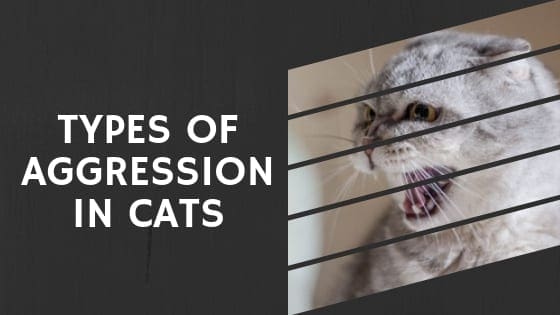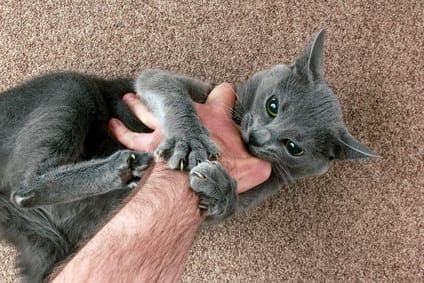
Aggression can be scary – not only for the victim but also for the one displaying the behavior. Since cats prefer to avoid confrontation, engaging in an aggressive encounter usually means they feel backed into a corner.
In order to avoid actual physical encounters, cats do lots of posturing and use their bodies to communicate that they’re either big, bad cats who shouldn’t be messed with or else they’re trying to say they’re not a threat. When the body language and other communication signals fail to stop perceived threats, and a cat feels there’s no means of escape, that’s when aggression may be the only option.
Cats aren’t aggressive just for the sake of being aggressive. There are different causes behind aggressive behaviors. You have to identify the underlying cause of the behavior in order to work toward correcting the problem.
One very important step in dealing with aggression, or any change in your cat’s behavior is to have them examined by the veterinarian in order to rule out any underlying medical cause. This is a crucial step that mustn’t be skipped. Very often, aggressive behavior is the result of any underlying medical issue, or it could be the result of pain.
Aggression is serious and people or cats can quickly become seriously injured. Before dealing with a cat who is acting aggressively, seek the advice of your veterinarian. You may then be referred to a qualified, certified behavior professional. In general though, the best way to deal with an aggressive cat is to not deal with him at all while he’s agitated – just leave the cat alone.
Below are some common causes of aggression:
Redirected Aggression
This occurs when a cat becomes aroused and reactive as a result of seeing or hearing something he can’t access. A common example is when an indoor cat sees an unfamiliar cat in the yard. He can’t get to the cat so he lashes out at a housemate cat or dog, or nearby human.
Redirected aggression is easily misdiagnosed because you may never see the actual source of the cat’s agitation. The cat can stay reactive for quite a while. Additionally, depending on how severe the aggressive encounter was, the housemate cats may stay hostile toward each other long after the initial episode.
Safely separating the cats temporarily is typically the best way to avoid the situation getting any worse. The sooner the cats get separated, the greater the chance of them getting over the episode without longterm effects. In some cases, a reintroduction is needed.
Petting-Induced Aggression
This is one that cat parents often think comes out of the blue, but in reality, the cat usually gives plenty of warning signs. The problem is, humans don’t always pay attention to the signals until it’s too late.
This type of aggression occurs when the cat parent is petting the cat and then he suddenly lashes out and either bites or scratches. It can occur when the cat parent strokes beyond the cat’s tolerance or when petting causes over-stimulation. It can also happen when stroking areas of the cat’s body that aren’t comfortable.
Cats usually give signs such as tail lashing, tail thumping, cessation of purring, skin twitching, body position shifting, meowing or ear twitching.
To avoid petting-induced aggression, pay attention to the cat’s body language signals and learn tolerance levels so you can stay well below that.

Fear Aggression
Basically, all types of aggression are rooted in fear. This is a cat who feels backed in a corner and has no other option but to lash out.
Veterinarians are the ones who often see cats displaying fear aggression. The cat is on the exam table and all crouched down with tail tightly tucked around his body. The cat is terrified and trying to appear as small as possible. He’s saying “leave me alone” but of course, he can’t be left alone during a veterinary exam. As a result, he may feel he has no choice but to strike.
If the fear is severe enough, the cat may also urinate, defecate, or express anal glands.
If a cat is displaying fear aggression and you don’t need to interact with him, the best thing to do is leave him alone and provide a place of refuge and security until he calms down. It’s also important to figure out what is triggering the fear.
In the case of fear aggression at the veterinary hospital, many veterinarians are incorporating Fear-Free techniques. This is an education program for the veterinary staff to help make veterinary visits easier for animals. Veterinarian, technicians, and staff can become individually certified or the entire hospital can become certified. The program was started by Dr. Marty Becker and more and more veterinary clinics are getting involved.
Play-Related Aggression
It’s not uncommon for a cat parent’s unsuspecting ankles to become the victims of a cat’s play aggression. An orphaned cat or one taken away from littermates too early may display this type of aggression because he was denied the social play that occurs during crucial time with siblings.
This type of aggression can also be displayed if you rough-house with the cat during play or use hands as toys. It’s important not to send a mixed message when it comes to playtime. Never tease or use your hands as toys. Play aggression is usually easily corrected by using interactive toys for play sessions teaching the cat that biting skin will result in a sudden end to the game.
Territorial Aggression
In the outdoor world, territorial aggression is actually very common. It can range from hissing and posturing to all-out bloody war. Territorial aggression can be displayed toward anyone – human, feline or canine – although it’s most typically displayed toward other cats. Territorial aggression is often displayed when a new cat is introduced into the household. Dealing with this type of aggression will depend on the underlying cause of the turf war. To avoid territorial aggression during a new cat introduction, use techniques that include a gradual, positive intro to avoid stressing both cats out. Cats are social creatures but that social structure is centered around resource availability. A big part of the aggression during an introduction is the fear of having resources threatened.
Pain-Induced Aggression.
This can happen if you touch the cat in a spot where he’s hurting or injured, or if pain is inflicted. This is just one of the many reasons why physical punishment isn’t an effective training method. This type of aggression may also occur if a child pulls a cat’s tail, or if the cat is handled too roughly. This type of aggression may show up in older cats who develop arthritis and it becomes very painful when not handled gently enough.
Non-Recognition Aggression
This type of aggression may occur in a multicat household when one cat returns after an extended absence and is attacked by the cat(s) who remained at home. It can also happen when a cat returns from a particular place such as the veterinary clinic. Since cats use scent as an important identification tool, the returning cat may smell unfamiliar or, in the case of a veterinary visit, may smell threatening. The smells associated with the veterinary clinic aren’t ones cats typically view as positive.
The cause of non-recognition aggression may include:
- The returning cat not smelling familiar due to a long absence
- The smell of disinfectant, medicine or other other chemical smells associated with the veterinary clinic
- A change in the returning cat’s normal scent due to illness
- A change in the returning cat’s behavior as a result of being fearful or in pain at the veterinary clinic
- Unfamiliar scent from being bathed or groomed at the veterinary clinic or professional groomer
- The scent of unfamiliar animals on the returning cat after being handled by veterinary or grooming staff
- The scent of stress pheromones released from the returning cat due to fear while at the clinic
The most effective way to treat this type of aggression is to keep the returning cat in a separate room for a while. This gives him a chance to groom and take on his familiar scent. It also gives the cat a chance to take on the normal scents of the home again. If you know from previous experience that the cat who stayed at home displays non-recognition aggression, be sure to not even let the cats see each other until after the returning cat has been separated for a while. In some cases, a mini-reintroduction may be needed to help them remember that they already know and like each other.
Predatory Aggression
Predatory behavior involves such as stalking, chasing, ambushing, pouncing, attacking, and capturing. Predatory behavior toward appropriate prey is a normal part of feline life. Cats are predators and if allowed outdoors, they will most likely hunt prey such as birds, mice, and even insects. The only way to control predatory behavior is to keep cats indoors.
If a cat is displaying predatory behavior toward a family member, it may be an indication that the cat doesn’t have adequate outlets for energy release. Cats need regular interactive play sessions conducted by cat parents. The interactive toy allows you to direct the cat’s focus (and teeth) toward the appropriate object. Cats also need solo playtime and enrichment. Puzzle feeders may also be a good addition because they keep the cat busy for a while and then a food reward is received for a job well done. For a cat left alone all day, puzzle feeders may provide a much needed energy release so the cat isn’t ready to pounce the second you walk through the door at the end of the day.
If the cat displays serious predatory aggression toward you or a family member, it’s helpful to carry objects to divert the cat’s attention away from ankles or feet. Carrying a toy that can be tossed, or rolling a ping pong ball may help direct the cat’s focus toward the toy so you can move through the room safely. A piece of cardboard to use as a body block can help as well.
Predatory aggression can result in serious injury. Talk to your veterinarian for a referral to a veterinary behaviorist or certified cat behavior consultant.
Unprovoked Aggression
This refers to aggression that is displayed for no reason at all that you and the veterinarian can determine. There may be an underlying medical reason for the behavior that has gone undiagnosed. Often, redirected aggression is misdiagnosed as unprovoked aggression. Before diagnosing unprovoked aggression, it’s crucial to rule out medical causes and all other potential causes of aggression. Unprovoked aggression is rare. A veterinary behaviorist or certified cat behavior consultant may be needed to help with this problem.
Maternal Aggression
A queen may display aggression if she feels her kittens are in danger. She may show aggression toward humans or other animals in the environment. It’s best to not stress the mother cat out. Make sure she has a safe and secure place so she doesn’t feel that her family is in danger. During the first two weeks of the kittens’ lives, limit interaction so the mother can tend to her new babies.
Need More Information?
For more information on cat behavior and training, refer to the best-selling books by Pam Johnson-Bennett. Pam’s books are available at bookstores and online. We’ve included links to Amazon here on our site.
If you have a question about your cat’s behavior or health, contact your veterinarian. This article is not intended as a medical diagnosis nor is it a replacement for your cat’s regular veterinary care. This article is for general information purposes only.







